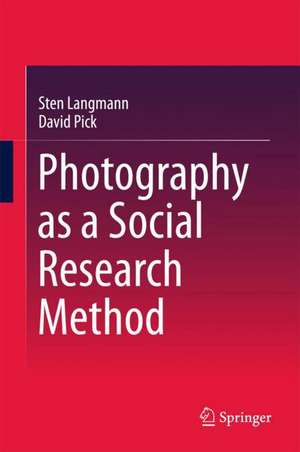Photography as a Social Research Method
Autor Sten Langmann, David Picken Limba Engleză Hardback – 14 mar 2018
| Toate formatele și edițiile | Preț | Express |
|---|---|---|
| Paperback (1) | 693.02 lei 6-8 săpt. | |
| Springer Nature Singapore – 25 dec 2018 | 693.02 lei 6-8 săpt. | |
| Hardback (1) | 693.02 lei 6-8 săpt. | |
| Springer Nature Singapore – 14 mar 2018 | 693.02 lei 6-8 săpt. |
Preț: 693.02 lei
Preț vechi: 815.31 lei
-15% Nou
Puncte Express: 1040
Preț estimativ în valută:
132.73€ • 136.75$ • 111.18£
132.73€ • 136.75$ • 111.18£
Carte tipărită la comandă
Livrare economică 24 februarie-10 martie
Preluare comenzi: 021 569.72.76
Specificații
ISBN-13: 9789811072772
ISBN-10: 9811072779
Pagini: 239
Ilustrații: XII, 167 p. 46 illus.
Dimensiuni: 155 x 235 x 18 mm
Greutate: 0.45 kg
Ediția:2018
Editura: Springer Nature Singapore
Colecția Springer
Locul publicării:Singapore, Singapore
ISBN-10: 9811072779
Pagini: 239
Ilustrații: XII, 167 p. 46 illus.
Dimensiuni: 155 x 235 x 18 mm
Greutate: 0.45 kg
Ediția:2018
Editura: Springer Nature Singapore
Colecția Springer
Locul publicării:Singapore, Singapore
Cuprins
Chapter 1: Foundations.- 1.1: The role of research photography within visual research methods.- 1.2: Different application and benefits of photo research.- 1.3: Photographs as a foundation and a serious data source for social research.- Chapter 2:Field Preparations.- 2.1: Lenses and their Function.- 2.2: Foundations of Photography.- 2.3: Photo perspectives and their different uses.- 2.4: RAW is the new JPG.- Chapter 3: Ethical Considerations in Research Photography.- 3.1: Current ethical considerations in research photography.- 3.2: Dignity in photo research.- 3.3: Verstaendnis, perceived realities, and power.- Chapter 4: In the Field.- 4.1: Equipment usage in the field.- 4.2: Translating research ethics into practical ethics in field work.- 4.3: Achieving dignity and Verstaendnis in field work to bridge power relations.- 4.4: Generating authentic data.- Chapter 5: Data Analysis.- 5.1: Photos as ‘data’.- 5.2: Deconstructing images from basics to specifics.- 5.3: Introduction to QSR NVivo – basic coding and theming functions.- 5.4: Photo coding and creation of themes in NVIVO.- Chapter 6: Presentation and Publication.- 6.1: Retouching and presentation foundations.- 6.2: Colour and black and white presentation of images.- 6.3: Legalities in the publication of images.- 6.4: Choosing an appropriate journal.
Notă biografică
Sten Langmann completed his PhD at Curtin University in Western Australia in 2014. His main research focus is on knowledge sharing for development and how development organisations which are engaged in knowledge clusters can help people to build capacities. Further research interests include the use of photography as useful and viable data collection method. In addition, Sten also has undertaken research into developing a new approach to training evaluation in HRM.
David Pick is an Associate Professor in the School of Management at Curtin University. Since gaining his PhD in 2003, he has published research in social policy in a variety of contexts including the North West of Australia, Bhutan and Myanmar. In addition to an interest in visual research methods, he has also undertaken research into the use of fictional narratives in understanding organizations.
Textul de pe ultima copertă
This book focuses on photography within the social research field, building a solid foundation for photography as a social research method and describing different techniques and applications of photo research. It provides a comprehensive approach to research photography, from preparation and the ethical considerations that need to be understood prior to going into the field, to collecting data, analysis and preparing research for publication. It also introduces artistic genres of photography to help readers with the choices they make when pursuing photographic research and as a reminder that when collecting photographs that they are in fact producing art. The ethical issues examined place a new focus on dignity and considerations of participant anonymity and recognition, informed consent, working with vulnerable groups, unequal power relationships and possible intervention. Combining preparation and ethics, it examines how best to collect and take good photographs, and explores the practical issues of stigma and introduces Verstaendnis (german: understanding) to aid researchers in the field. Subsequently, the book discusses the different photo-analytical approaches for researchers and provides examples of how to analyse photographs using the different techniques. Lastly, it offers guidelines, with examples, for researchers wanting to publish their work
Caracteristici
Highlights both the theoretical foundations and practical applications of research photography Introduces the different domains of research photography. Focuses strongly on the theoretical and practical ethical concerns in research photography Offers example-based teaching using photographs from research projects to illustrate genres, deconstruction and analysis, and presentation Provides guidance to readers, from the initial steps to the final published work
